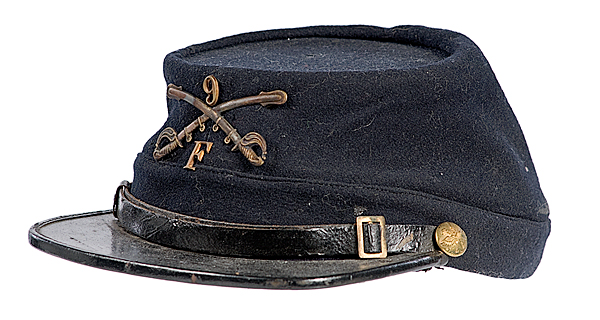This item is an 1889 model of a Buffalo Soldier forage cap. It has an attached 1872 model brass cavalry insignia that shows two crossed swords. Above the swords is the regimental number ‘9’, and below the swords is the troop letter, ‘F’. Buffalo Soldiers belonged to one of two regiments, the Ninth United States Cavalry or the Tenth United States Cavalry. The regimental number ‘9’ means that this cap was used for the Ninth United States Cavalry, commanded by Colonel Edward Hatch of Iowa. The two regiments were divided into a number of smaller troops. The troop letter ‘F’ means that this cap was used by a soldier in Troop F, led by Lieutenant Colonel Wesley Merritt in Fort Davis, Texas.
In 1866, the United States Congress authorized two regiments of African American cavalry, the Ninth United States Cavalry and the Tenth United States Cavalry, to be added to the United States army. For the first time in the history of the United States, African Americans were able to join the army during peacetime. The term ‘Buffalo Soldier’ was given to these two cavalry regiments by the Plains Indians since the hair of these soldiers appeared similar to a bison’s curly black hair. The term caught on with the soldiers themselves, and they eventually added a bison to their regimental crest.
Following the Civil War many African American men joined the army, seeing it as an opportunity for advancement. As soldiers they were fed, clothed, sheltered and earned $13 per month. Initially, white officers were reluctant to lead a regiment of African American men, believing that they would be obstinate and difficult to manage. Once the white officers were in place, they soon found that their fears were misplaced. The degree of drunkenness and desertion of African American regiments was far lower than white units.
The Buffalo Soldiers were stationed at a variety of posts in Texas from 1866 to 1890. The Ninth United States Calvary was ordered to western and southwestern Texas in 1867 to protect the area between the Rio Grande and Concho Rivers from Native American attacks. Troop F, along with troops C, D, G, H and I, were under Lieutenant Colonel Wesley Merritt in Fort Davis. Fort Davis was situated on the Trans-Pecos portion of the San Antonio-El Paso Road and the Chihuahua Trail. Its location allowed for greater ease in controlling activities on the Mescalero Apache war trails and the Great Comanche war trail during the American Indian Wars, a period when Native Americans were being forcibly removed from their land.
The motto of the Ninth United States Cavalry was, “We Can, We Will.” This motto truly guided the regiment as they carried out a variety of assignments. The soldiers protected the frontier, recovering livestock, capturing horse thieves and serving justice. They restored a number of forts, built roads, hung thousands of miles of telegraph lines and escorted stagecoaches, wagons, mail parties, survey parties, railroad trains and railroad crews. The soldiers even partook in frontier campaigns. Perhaps most importantly, the Buffalo Soldiers of the Ninth United States Calvary overcame prejudice on the frontier and were greatly respected for their hard work and contributions.
